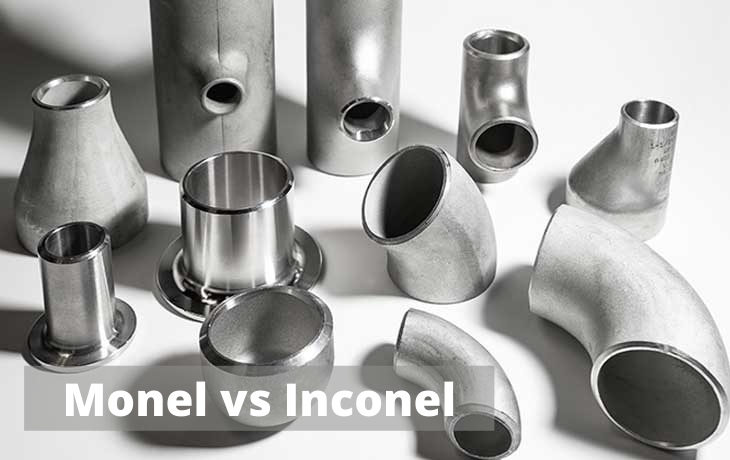Comparison between Monel and Inconel
Posted on 10 October , 2020 at 4:05 PM

The key distinction somewhere in the range of Inconel and Monel is that Inconel is a nickel–chromium-based amalgam, while Monel is a nickel-copper based compound. Inconel and Monel are regular trade names in the industry. They are two gatherings of superalloys that have amalgams with outrageous erosion opposition. Notwithstanding, the two kinds are exceptionally costly too. It is a direct result of their costly creation measure.
What is Inconel?
Inconel is a trading name of a gathering of superalloys. It contains austenitic nickel and chromium-based superalloys. Makers have explicitly improved these compounds so as to meet the hardest conditions during use. At the end of the day, Inconel has high resistance towards outrageous warmth and can keep its rigidity at high temperatures with no change. Inconel is a combination of nickel (50-72%) and chromium (14-21%) and furthermore contains iron and molybdenum. Inconel is viewed as a superalloy and extraordinary metals with explicit applications. It has a few attributes that make it an attractive metal. Inconel amalgams are impervious to consumption which makes it reasonable for some extraordinary conditions. It is likewise impervious to oxidation and can withstand high temperatures. At the point when it is presented to warm, Inconel frames a layer to shield the surface from heat and other harm. It doesn’t possibly heat-safe however keeps up its quality when heated. Nonetheless, this material is costly. Notwithstanding enduring extraordinary warmth, these combinations are oxidation-consumption safe. At the point when warmed, this material structures a thick and stable oxide layer. Also, this oxide layer can shield the outside of the composite from further assault from heat. There are different varieties of Inconel compounds, beginning with Inconel 600 which contains in any event 72% Nickel, between 14 – 17% Chromium, between 6-10% Iron, and different components like Carbon, Manganese, Silicon, and so on. Inconel 625 which contains in any event 58% Nickel, between 20-23% Chromium, around 5% Iron, between 8-10% Molybdenum, between 3.15-4.15% Niobium (in addition to Tantalum), and different components like Carbon, Manganese, Silicon, and so forth. Inconel 718 includes 50-55% Nickel (in addition to Cobalt), 17-21% Chromium, 4.75-5.50% Niobium (in addition to Tantalum), 2.80-3.30% Molybdenum, and other concoction parts like Iron, Cobalt, Carbon, Manganese, Silicon in a little rate. Every one of these varieties is notable for their high-quality, erosion opposition, high return quality, rigidity, and creep-break properties, and so forth. Inconel is ideal over hardened steel in heat treat applications, fast temperature changes, when an introduction to saltwater is required, in-stream motors, and so forth. Additionally, this material is regular in gas turbines cutting edges, seals, high-temperature latches, and so forth.What is Monel?
Monel is a trading name for a gathering of nickel-copper amalgams. These composites contain nickel transcendently with copper and barely any different substances including iron, manganese, carbon, and silicon. The nickel content commonly extends from 52 to 67%. There are numerous varieties of Monel amalgams, beginning with Monel 400, which contains at any rate 63% nickel, somewhere in the range of 29% and 34% copper, somewhere in the range of 2% and 2.5% iron, and somewhere in the range of 1.5% and 2% manganese. Monel 405 includes close to 0.5% silicon, and Monel K-500 includes somewhere in the range of 2.3% and 3.15% aluminum and somewhere in the range of 0.35% and 0.85% titanium. These and different varieties all are esteemed for their protection from assault by acids and antacids, just as for their high mechanical quality and great flexibility. Monel 400 contains a similar amount of nickel and copper as is found in normally happening nickel metal. It has high quality and can be solidified uniquely by chilly working. Because of its protection from decay, Monel 400 is frequently utilized in parts found in marine and concoction conditions. While it is a helpful metal, it is cost-restrictive in many applications. Monel 400 costs 5 to multiple times more than standard nickel or copper. Subsequently, it is utilized once in a while—and just when no other metal could do a similar activity. For instance, Monel 400 is one of only a handful of combinations that keeps up its quality in below zero temperatures, so it is utilized in those conditions. Also, this composite is more grounded than an unadulterated nickel. Additionally, it is impervious to consumption by different specialists, even by streaming ocean water. The creation strategies incorporate hot-and cold-working, machining, and welding. All the more significantly, this combination is exceptionally costly; for instance, channeling with Monel as opposed to carbon steel is multiple occasions costly. Accordingly, the utilization of this combination is restricted. Thinking about the utilization, the uses of this composite are in the field of aviation applications, oil creation, refining, marine applications, instruments, and so forth. A few evaluations of Monel incorporate Monel 400, Monel 401, Monel 404, and so on.What are the Similarities Between Inconel and Monel?
- Inconel and Monel are exceptionally erosion safe.
- Also, they are profoundly costly.
- Likewise, both contain nickel as the dominating material.